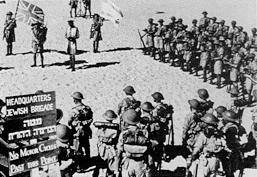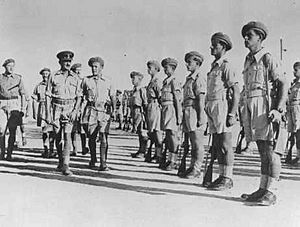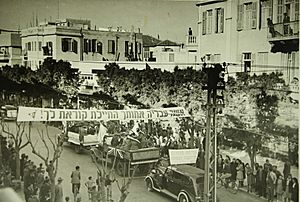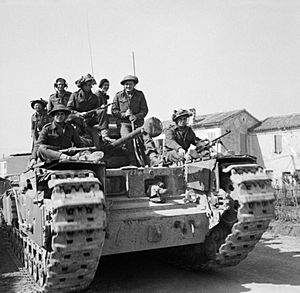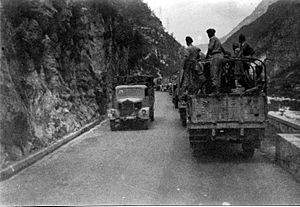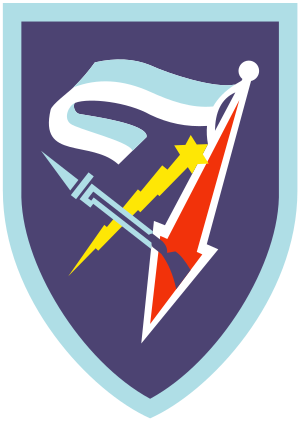Jewish Brigade facts for kids
Quick facts for kids Jewish Brigade |
|
|---|---|
 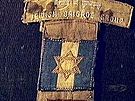
Insignia and sleeve patch of the Jewish Brigade
|
|
| Active | 1944–1946 |
| Country | |
| Branch | |
| Type | Infantry |
| Size | 5,500 Palestinian Jews |
| Engagements | |
| Commanders | |
| Notable commanders |
Ernest Benjamin |
The Jewish Brigade was a special military group. It was part of the British Army during the Second World War. This group was made up of Jewish volunteers. Most of them came from Mandatory Palestine, which is now Israel. British Jewish officers led them.
The Brigade fought in Italy in the last part of the war. It was officially formed in late 1944. The group was disbanded in 1946. After the war, some members of the Brigade helped Holocaust survivors. They helped them move to Mandatory Palestine. This was often done secretly, against British rules.
Contents
Why the Jewish Brigade was Formed
British Support for a Jewish Homeland
After World War I, Britain became a major power in the Middle East. This brought the idea of a Jewish homeland closer to reality. The Balfour Declaration was a statement from the British government. It supported the creation of a Jewish homeland in Palestine. This led to many Jewish people moving to Palestine. This continued through the 1920s and 1930s. The Jewish population grew by over 400,000 people. This happened before World War II began.
However, in 1939, the British government changed its mind. They seemed to go back on the Balfour Declaration. They limited Jewish immigration and land purchases in Palestine. When Britain declared war on Nazi Germany in September 1939, Jewish leaders had a clear goal. They wanted to fight the war against Germany. But they also wanted to continue working for a Jewish homeland.
How the Jewish Brigade Started
Chaim Weizmann, a leader of the Zionist Movement, offered help to the British. He wanted a Jewish fighting group within the British Army. At first, the British said no to a separate Jewish group. They allowed Jewish volunteers to join other British units. These units were often for support roles, like transport or engineering. They were not main combat units.
Jewish groups kept asking the British government for a dedicated Jewish fighting force. Many British officials were worried. They feared such a force might later fight against British rule. But in August 1944, British Prime Minister Winston Churchill finally agreed. He was deeply affected by the terrible killings of Jewish people in Hungary. He also hoped to gain support from the American public.
The Jewish Brigade in Action
Forming the Brigade
Reports of the terrible crimes of the Holocaust became known in 1942. After this, Prime Minister Churchill suggested forming a Jewish fighting group. He felt that Jewish people had the right to fight the Germans as a clear group. US President Franklin D. Roosevelt agreed.
After much discussion, the British government agreed on July 3, 1944. They allowed the creation of a Jewish Brigade. On September 20, 1944, the British War Office officially announced it. The Jewish Brigade Group was formed. Its headquarters were set up in Egypt. The Zionist flag was approved as its official symbol.
The Brigade included over 5,000 Jewish volunteers. They came from Mandatory Palestine. They were organized into three infantry battalions. They also had supporting units, like an artillery regiment.
- 1st Battalion, Palestine Regiment
- 2nd Battalion, Palestine Regiment
- 3rd Battalion, Palestine Regiment
- 200th Field Regiment (Royal Artillery)
Newspapers like The New York Times welcomed the news. They said it was a long-awaited recognition of the Jewish role in the war.
Fighting in Italy


In October 1944, the Jewish Brigade went to Italy. Brigadier Ernest F. Benjamin led them. They joined the British Eighth Army in November. This army was fighting in the Italian Campaign.
The Jewish Brigade took part in the Spring Offensive of 1945. They first went to the front line on March 3, 1945. They fought against German forces along the Senio River. The Brigade carried out patrols and small attacks. They fought many small battles to improve their positions. They also captured German soldiers.
The Brigade had its first major battles on March 19–20, 1945. They fought at Alfonsine. In these fights, they killed 19 German soldiers and captured 11. The Brigade then moved to the Senio River area. On March 27, they fought against parts of the German 4th Parachute Division.
From April 1-9, the Brigade continued to fight in small battles. They returned to bigger attacks during the "Three Rivers Battle." On April 10, they crossed the Senio River. They captured their assigned positions and created a safe area. They also cleared out a strong German position that another Allied unit could not capture. The Brigade then fought more small battles. They captured Monte Ghebbio after a fight with German paratroopers.
The Brigade was then taken off the front line to rest. This was before the liberation of Bologna on April 21, 1945. The Brigade's engineers also helped build bridges over the Po River. This allowed Allied forces to cross. The Jewish Brigade spent 48 days fighting on the front line in Italy.
After the fighting, the Jewish Brigade was stationed in Tarvisio. This was near the borders of Italy, Yugoslavia, and Austria. They searched for Holocaust survivors. They gave them help and assisted them in moving to Palestine. They played a key role in helping Jews escape Europe. This role continued even after the Brigade was disbanded. They also helped educate and care for children who survived the Holocaust. In July 1945, the Brigade moved to Belgium and the Netherlands.
During World War II, 83 members of the Jewish Brigade were killed or died from wounds. Another 200 were wounded. Their graves are in the Ravenna War Cemetery in Italy.
After the War
Helping Survivors and Tracking War Criminals
The Jewish Brigade was disbanded in the summer of 1946. After the war, many members of the Jewish Brigade helped Holocaust survivors. They supported the "Bricha" movement. This movement helped Jewish survivors illegally immigrate to Mandatory Palestine. Brigade members sometimes provided British Army uniforms and documents. This helped Jewish civilians who were organizing the immigration.
Some members of the Jewish Brigade also joined groups. These groups worked to find and bring to justice former German officers. These officers had taken part in terrible crimes against Jewish people during the war.
Military Legacy

In 1948, after Israel became an independent country, many Jewish Brigade veterans joined the Israel Defense Forces. They served with great honor during the 1948 Arab–Israeli War. Many veterans became high-ranking officers in the Israeli military. Thirty-five of them became generals.
Awards and Recognition

Many soldiers in the Jewish Brigade received awards. Seventy-eight were mentioned for their bravery. Twenty received military decorations. These included seven Military Medals and four Military Crosses. Veterans of the Brigade later received the Volunteer Ribbon and the Fighters against Nazis Medal from Israel.
On October 3, 2018, the Jewish Brigade Group received a special award from Italy. It was the Italian Gold Medal of Military Valour. This was for their important role in freeing Italy during World War II. The medal was attached to the flag of the Israeli 7th Armored Brigade. This brigade is seen as carrying on the legacy of the Jewish Brigade Group. The ceremony took place in Israel.
Lasting Impact
The Jewish Brigade has inspired many books and films. In 1998, a documentary called In Our Own Hands was released. It told the story of the Brigade. The film was shown on TV and at film festivals around the world.
Notable Veterans of the Jewish Brigade
These are some of the well-known people who served in the Jewish Brigade:
- British Jews
- Ernest Benjamin
- Bernard M. Casper
- Edmund Leopold de Rothschild
- Palestinian Jews
- Yehuda Amichai
- Meir Argov
- Ted Arison
- Hanoch Bartov
- Yehoshua Bar-Hillel
- Haim Ben-Asher
- Zvi Brenner
- Reuven Dafni
- Yehiel Duvdevani
- Israel Carmi
- Mordechai Gichon
- Amir Gilboa
- Elazar Granot
- Dov Gruner
- Hans Jonas
- Shraga Har-Gil
- Haim Laskov
- Mordechai Maklef
- Shimon Mazeh
- Nissan Nativ
- Yitzhak Orpaz
- David Rubinger
- Gideon Schocken
- Shlomo Shamir
- Chaim Sheba
- Mordechai Surkis
- Israel Tal
- Adin Talbar
- Moshe Tavor
- Yehoshafat Harkabi
- Aharon Hoter-Yishai
- Yigal Hurvitz
- Danny Matt
- Gideon Ben-Yisrael
- Meir Zorea
- Amram Zur
- Shalom Zysman
See also
 In Spanish: Brigada Judía para niños
In Spanish: Brigada Judía para niños
- Jewish Legion
- Volunteer Ribbon


